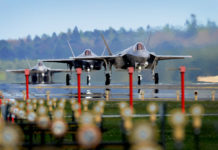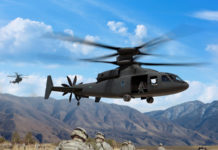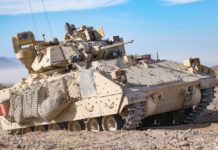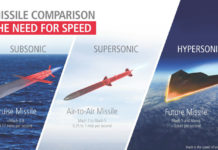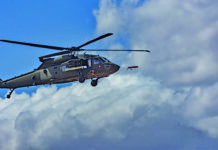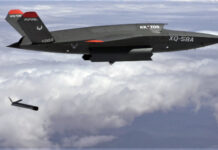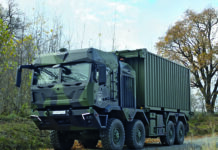Many 4×4 light military vehicle types are designed as multitaskers. Depending on configuration, they can:
- deploy as reconnaissance or liaison vehicles
- conduct light strike missions
- support dismounted infantry with a variety of weapons
- act as tactical troop transports
- carry out logistics missions including battlefield resupply.
While some rely solely on speed and manoeuvrability for survival, others can be fitted with removable modular armour. Depending on total weight as well as mission profile, some permanently protected vehicles can also be classified as light tactical vehicles.
North America JLTV
An eight-year production contract for the Joint Light Tactical Vehicle (JLTV) was awarded to Oshkosh Defense in 2015, with the understanding that a competition for a follow-up contract award would be conducted for continued procurement after completion of the initial award period. More than 15,000 of the 16,901 vehicles called for under the initial contract have been delivered to date, primarily to the US Army and US Marine Corps (USMC). Deliveries under this contract will continue through 2024. International sales of the JLTV continue to intensify. Export permits have been awarded to seven nations, including several NATO-frontline nations in Eastern Europe.
The largest potential acquisitions have been approved for the UK (up to 2,447 vehicles) and Lithuania (up to 500 units, although to date only 200 have been ordered for delivery through 2024). The JLTV Family of Vehicles (FoV) is a classic example of multitasking. There are two basic variants: the four-seat Combat Tactical Vehicle (CTV) with a 1,600 kg payload, and the two-seat Combat Support Vehicle (CSV) with a 2,300 kg payload. Both variants can tow a cargo trailer specifically configured for the JLTV.
The CTV can be configured for three mission types: General Purpose (including transport of a four-person fire team), Heavy Gun Carrier, and Close Combat Weapon Carrier. Weapons options include turret-mounted guns up to 30mm, anti-tank missiles (ATMs), short-range air-defence missiles, and a 120mm mortar. The heavier weapon options make the JLTV a viable combatant even in peer-level conflicts, providing fast-moving light infantry units a powerful offensive capability.
The CSV is designed for the Utility and Shelter Carrier mission. Depending on the mission, the open-bed cargo space can be directly loaded with equipment and supplies, or it can be outfitted with a specialised utility shelter or shell. The latter permits deployment of the vehicle in various specialised roles, including:
- as a field ambulance
- repair/maintenance vehicle
- communications/command vehicle
JLTV Options
The JLTV’s versatility has been further proven by the development of additional operational concepts, primarily for the CSV. These include equipping the CSV with a Boeing SHOrt-Range Air Defense (SHORAD) turret; mounting a 105mm howitzer on the cargo bed to create a mobile artillery capability for light infantry units; and deploying Kongsberg Light Strike Missiles on a modified unmanned JLTV chassis to create a mobile shore-based anti-ship missile capability.
Payloads only account for a portion of the JTLV capabilities package. Its manoeuvre profile is essential for maximising offensive and defensive capabilities and the ability to access terrain which would stymy heavier vehicle types. Oshkosh’s proprietary TAK-4i intelligent independent suspension system uses compressed nitrogen to automatically adjust to driving conditions, enhancing the ability to master broken terrain while easing occupant discomfort.
The JLTV programme office released the solicitation for the follow-on procurement contract in February 2022 (with a closing date of 12 April 2022 for bids). In addition to Oshkosh, competitors are expected to include AM General, GM Defense and Navistar Defense. The single-award contract for delivery of 16,600 vehicles will have a five-year duration.
A selection is expected during the fourth quarter of fiscal year 2022 (July-September 2022).
The JLTV produced under the follow-on contract will be designated the A2 variant. The programme office is planning some performance upgrades for the A2. The current Banks Power-modified GM Duramax engine will be replaced by the next-generation engine by the same manufacturer. Modifications to the alternator, drive gears and vehicle insulation will reduce the acoustic profile, both externally and within the passenger compartment. Improved fuel efficiency is another goal. One solution here is the planned utilisation of lithium-ion batteries to power on-board electrical systems while the vehicle is stationary, reducing the need to idle the engine. Externally mounted cameras will provide vehicle occupants with a 360-degree situational awareness. Delivery of the first A2 production units is expected in 2025.
ISV
One drawback of the JLTV is the limitation to only four soldiers per vehicle. The US Army is acquiring the Infantry Squad Vehicle (ISV) as a light tactical vehicle capable of transporting an entire nine-member infantry unit including heavy crew served weapons (machine guns, ATMs) and 72 hours worth of supplies (payload capacity 1,450 kg). In 2020, the Army selected General Motors to develop the ISV on the basis of the commercial Chevrolet COLORADO ZR2 pickup truck. The militarised design features a completely new hull, but otherwise retains 70 percent commonality with the civilian truck, including the multimatic DSSV dampers that enhance off-road performance. Being smaller and lighter than the JLTV, the ISV can be transported internally via CH-47 or sling-loaded beneath a UH-60 helicopter. The 2020 contract calls for procurement of 649 vehicles out of a long-term goal of 2,065 vehicles.
A report issued in February 2022 by the Pentagon’s Director of Operational Test and Evaluation (DOTE) criticised the ISV’s performance during Initial Operational Test and Evaluation (IOT&E) in August 2021. Negative design aspects included insufficient space for the required 72 hours worth of supplies; the lack of side panels or a top, which exposed soldiers to injury while traversing forest terrain; the lack of an integrated communications system which hampered situational awareness; and difficulty accessing and deploying weapons while the vehicle is moving. Structural faults were also noted. These manifested primarily during the IOT&E’s desert scenario, and resulted in intermittent loss of steering capability, and engine cracks and failures.
Overall, the IOT&E report found that the design was “not operationally effective” for combat or engagement and security cooperation missions in a peer-level conflict. On the positive side, it praised the vehicle’s agility, cross-country capability, and low acoustic signature. “The ISV allows an infantry unit to move over extended distances rapidly, reducing fatigue,” the report noted.
The Army took issue with some conclusions, stressing that the operating concept did not call for the ISV to engage in combat; rather, it is conceived as a personnel transport, with infantry dismounting upon reaching an engagement zone. The ISV program office acknowledged the structural issues, emphasising that a corrective action plan was in place to address these problems before the Full Rate of Production decision is made in May 2022. System level reliability testing is planned for later in 2022 to assess the corrective measures.
NATO Europe URO VAMTAC
The VAMTAC LTV (Light Tactical Vehicle) introduced in 2021 is the latest iteration of the UROVESA VAMTAC (Vehículo de Alta Movilidad Tàctico – High Mobility Tactical Vehicle) FoV. The aluminium chassis of the base model restricts gross vehicle weight to 3,500 kg. The LTV is optimised for high off-road mobility and easy air transport. The cab accommodates five, while the open rear bed remains free for cargo. Alternately, a shell or tarp can be placed over the cargo bed. Total payload capacity is 1,000 kg.
The multi-purpose LTV can accept a weapons mount and modular armour to meet specific mission requirements. The LTV is preceded by the VAMTAC ST5, which was introduced in 2013; an armoured version – designated ST5 BN3 – was added in 2015. The ST5 is offered in numerous variants including:
- an eight-seat troop carrier
- a weapons carrier (heavy machine gun or a multi-mission missile launcher deploying MILAN or SPIKE ATMs)
- mortar carrier
- reconnaissance and surveillance vehicle
- command/control/communications vehicle
- field ambulance
- pickup truck/logistics vehicle
A 2018 order covering 139 ST5s for the Portuguese Army included four different configurations:
- troop carrier (107 units)
- command vehicle (seven)
- ambulance (13)
- special operations (12)
In addition to ballistic and mine protection, these vehicles featured the Rheinmetall ROSY L rapid obscuring system, the Critical Software EyeCommand battle management system, and the EID PRC 525 combat net radio. The command vehicles and a portion of the SOF variant were also configured with a satellite communications suite.
Iveco LMV
The first generation of the IVECO Light Multirole Vehicle (LMV) was introduced in 2006. The second generation LMV2 was presented in 2016. The newer variant features an upgraded 220 hp engine; an upgraded driveline capable of managing more power; a new air filtration system; enhanced suspension; a new automatic eight-speed gearbox and a new electronic stability control system. These upgrades optimize offroad performance. An enhanced digitized electronic architecture and power supply support additional vectronics and an electronic countermeasures (ECM) suite. The redesigned crew cell accommodates five soldiers in body armour plus weapons and supplies. Payload capacity has been increased by 40 percent to 1,500 kg.
The LMV2 is available in several variants with different combinations of short or long cab and short or long wheelbase. Configurations include the standard troop carrier, a special forces variant with an open rear cargo bay, a field ambulance, and a short-cab truck tractor. The LMV2 entered service with the Italian Army in 2021. Fulfilment of a 2019 procurement contract for the Royal Netherlands Army and Marine Corps is slated for the 2022-2027 timeframe. The contract covers 1,275 vehicles in five configurations.
SupaCat LRV
The SupaCat Light Role Vehicle (LRV) was introduced in 2019 at the DSEi expo. The 4×4 vehicle can be converted to a 6×6 configuration within a few hours by installing a third axle. This boosts the payload capacity from 1,700 kg to 2,350 kg. The highly modular open-cab vehicle can be configured with a canvas roof and side screens and a detachable polycarbonate wind screen, or with ballistic armour; seating and cargo layout can also be customised, including installation of ballistic-protected crew seats. An optional weapons mount can support machine guns up to 12.7mm or the Fletcher 70mm rocket launcher system. The vehicle supports various mission modules and can be optimised for long-range patrol and strike missions. Optional features for long-range missions in austere environments include a pinnacle compass and an on-board water boiler. The LRV can be internally transported by CH-47 and roll-off ready for action.
Jankel
Jankel’s Light Tactical Transport Vehicle (LTTV) entered full-rate production in November 2021 after passing the Belgian Ministry of Defence’s Preliminary Technical Acceptance milestone. The Belgian Army is procuring 199 of the highly modular vehicles, which are based on the Mercedes UNIMOG chassis. The LTTV is designed to provide maximum flexibility through easy re-configuration by the user, with a variety of removable mission modules or “rear hampers” to be mounted on the utility section.
The mission-specific modules are optimised for troop transport, special operations, medical support/field ambulance, and load carrying, respectively. Additional military subsystem options available, regardless of the installed mission hamper, include a ballistic armour kit, multiple machine gun and communications mounts, and a roll-over protection system. Further optimization is possible through application of cold-weather (-32 degrees Celsius) of hot-weather (+50 degrees Celsius) kits. Depending on configuration, the LTTV has a payload capacity of more than 3,000 kg and an enhanced towing capacity of 14 tons.
The LTTV augments Jankel’s multi-member FOX Family of light tactical/utility vehicles, which are based on the Toyota LAND CRUISER and Toyota HILUX chassis. The heavier members of this FoV are the Rapid Reaction Vehicle (RRV) and the Long-Range Patrol Vehicle (LRPV). These air-transportable all-terrain vehicles feature up to ten days mission endurance in austere environments and the ability to mount a variety of heavy firepower. Mission profiles include direct action strike missions, fire support, force protection and convoy escort, and reconnaissance and surveillance, in terrain or urban settings.
The FOX Light Utility Vehicle (LUV) seats two in a doorless cab. The open cargo bed can be configured for troop or cargo transport, as a water or fuel carrier, or as a mobile maintenance shop. Alternately, it can serve as a mortar platform. The highly modular Tactical Utility Vehicle (TUV) was added to the FOX lineup in 2021. The closed cab accommodates four. The cargo bed can serve as a gun platform (utilizing the removable “tactical pod”), or be enclosed with a neutral shell for covert and surveillance missions.
WIRUS-4
The first WIRUS-4 light high-mobility vehicles entered service with the Polish Army in December 2021. Designated as the Zmija LPU-1, the light armoured vehicles – which are domestically produced by manufacturer Team Concept – are configured as light strike and armoured reconnaissance vehicles. They are suitable for operations in difficult terrain including dense forests as well as rapid on-road movement.
The vehicle features front and rear double wishbone suspension, with independent front suspension and a rigid rear axle. The body is composed of high-strength chrome-molybdenum steel tubular construction incorporating composite laminate components. The floor incorporates ceramic-aramide composite laminate, which provides 1 armour protection. But the driver and commander seats have no doors, trading fast egress for protection.
The four-metre long, two-metre wide WIRUS-4 has a gross vehicle weight of 2,600 kg and a 900 kg payload capacity. It accommodates three including the driver, and has an additional rear cargo space. Machine guns are emplaced at the rooftop ring mount and the commander-side pintle mount; the ring mount can alternately accept a 40mm grenade launcher. Optronics systems to support the reconnaissance and surveillance mission can optionally be installed. The vehicle’s small footprint facilitates transport by sling beneath medium-lift helicopters. The Polish Army is acquiring a total of 118 units.
Team Concept has also designed a Special Operations Forces variant which seats four and can be equipped with driver and passenger side doors. It can be equipped with machine guns including 5.56mm Minimi, UKM 7.62mm, and 12.7mm.
YORUK NMS
The Nurol Makina YORUK NMS 4×4 light armoured vehicle was introduced in 2019 at the IDEF expo, preparatory to entering serial production. To date 250 units have been produced for the Turkish and Qatari armed forces.
The main configurations are the armoured combat vehicle, reconnaissance/surveillance, air defence, anti-tank, and the utility/cargo pickup truck variants. The standard armoured combat vehicle configuration holds seven plus the commander and the driver. Payload capacity is circa 4,000 kg. The vehicle’s low centre of gravity provides excellent stability and handling in urban and terrain settings. The 300 hp engine and six-speed automatic transmission permit road speeds of 140 km/h, while the front and rear independent suspension optimise off-road performance.
The base vehicle’s v-shaped monocoque body has STANAG level 1 protection, which can be increased to level 4 through various modular armour suites. The ballistic-protected glass can be strengthened in tandem with the body armour by adding applique laminate layers. Armour kit application can be conducted in the field without specialized equipment. The NMS can accommodate various Aselsan weapon mounts including: the remote-control Saro-Zafer stabilised turret for 7.62 or 12.7mm machine guns; the KORNET ATM-turret; and the IGLA antiaircraft turret.
Middle East Plasan SANDCAT
In November 2021, Plasan unveiled the STORMRIDER as the fifth and newest member of the SANDCAT light armoured vehicle family. At 11,500 kg gross vehicle weight, the STORMRIDER is the largest and heaviest member of the SANDCAT FoV. The newly designed Monococque hull features the strongest protection suite of any SANDCAT vehicle, up to STANAG 4569 Level 3, plus 2a/2b mine protection. Despite the added weight, the STORMRIDER displays the high mobility and versatility of earlier models. Like the SANDCAT IV introduced in 2018, the new variant accommodates up to ten combat-equipped soldiers (including the driver) in the Troop Carrier configuration. Other base configurations include the Utility vehicle (with a cab for five soldiers plus a cargo space) and the Single Cab variant (cab for three soldiers, plus a larger cargo bay).
The SANDCAT FoV is designed for tactical strike, special operations, and border security operations as well as for police SWAT units. The all-terrain vehicle performs well in urban settings and in the field. For the SANDCAT IV, Plasan reports top speeds of 120 km/h, acceleration to 96 km/h within 23 seconds and a turning radius of 12.3 metres. Six different integrated system modules are optional:
- Driver Assistant module (includes thermal cameras and a dashboard display, enabling driving and navigation under limited visibility conditions)
- Situational Awareness module (includes six external cameras and analytical software to provide a 360 degree situational picture of the vehicle’s immediate vicinity)
- Mission Management module (centralised command and control over on-board sensors, navigation systems, weapons, and electronic warfare systems)
- Vehicle Analytics module (collects and analyses data from vehicle components and systems to monitor vehicle health)
- Vehicle to Vehicle module (broadband data exchange between vehicles)
- Autonomous Vehicle Operations module (allows unmanned vehicle operation including remote operations and leader-follower scenarios).
Manual and remote weapon stations for machine guns and grenade launchers can be mounted. Heavier weapons such as Rafael SPIKE missiles or 120mm mortars can be installed on the utility variants.
NIMR AJBAN
NIMR’s AJBAN FoV includes eight 4×4 vehicle models optimized for various mission profiles. These include the second-generation AJBAN 4×4 Mk 2 introduced in early 2021. The Mk 2’s v-hull structure features enhanced ballistic protection and blast mitigation. Optimized as a protected light tactical patrol vehicle with optional roof-mounted armament, the Mk 2 has a 700 km on-road cruising range at 100 km/h. Off road, the ruggedised suspension master dynamic loads up to five times gravitational force, according to NIMR’s data sheet. A central tire inflation system allows tire pressure to be adjusted according to terrain conditions.
The AJBAN Mk 2 seats five soldiers. Total payload capacity is 2,900 kg. A ballistic protected cargo compartment is situated behind the crew cab. Mission readiness has been enhanced by streamlining replacement of the vehicle’s modular powerpack – including cooling, engine, transmission and transfer case – from previously ten hours to only 20 minutes.
Other AJBAN variants include the 440 and the armoured 440A, with a four-person capacity plus a large cargo bay, suitable for troop transport or logistic support missions; the two-seat 420 pickup truck; the soft-skin 450 SUV with an eight-person capacity; the open-top Long Range Special Operations Vehicle (LRSOV) which can accommodate gun mounts for all five occupants, as well as a centrally-mounted rocket launcher; and the 447A Multi-Role Armoured Vehicle which seats seven and can accommodate a turret-mounted Gatling gun. Overall, the AJBAN FoV represents a broad spectrum of applications including long-range patrol and reconnaissance, counterinsurgency and special operations, border security, tactical response, and logistic support. Scalable modular armour for ballistic and blast protection is available on most models.
Mobile and Versatile
Mobility and versatility are the great strengths of light tactical/utility vehicles. Most can be airlifted internally and externally by medium- or heavy lift helicopters, or be parachute-deployed by transport airplanes. On the ground, they can traverse most terrain, and can operate freely in urban areas that could prove challenging to larger, heavier vehicles. Manoeuvrability and a low profile enhance survivability, compensating for a lack of heavy armour. The ability to mount a wide variety of sensors and weapons confers the ability to act as force enablers and to effectively engage much heavier opponents, up to and including tanks or helicopters. This versatility will ensure the continued need for light tactical and utility vehicles for the indefinite future.
Sidney Dean






